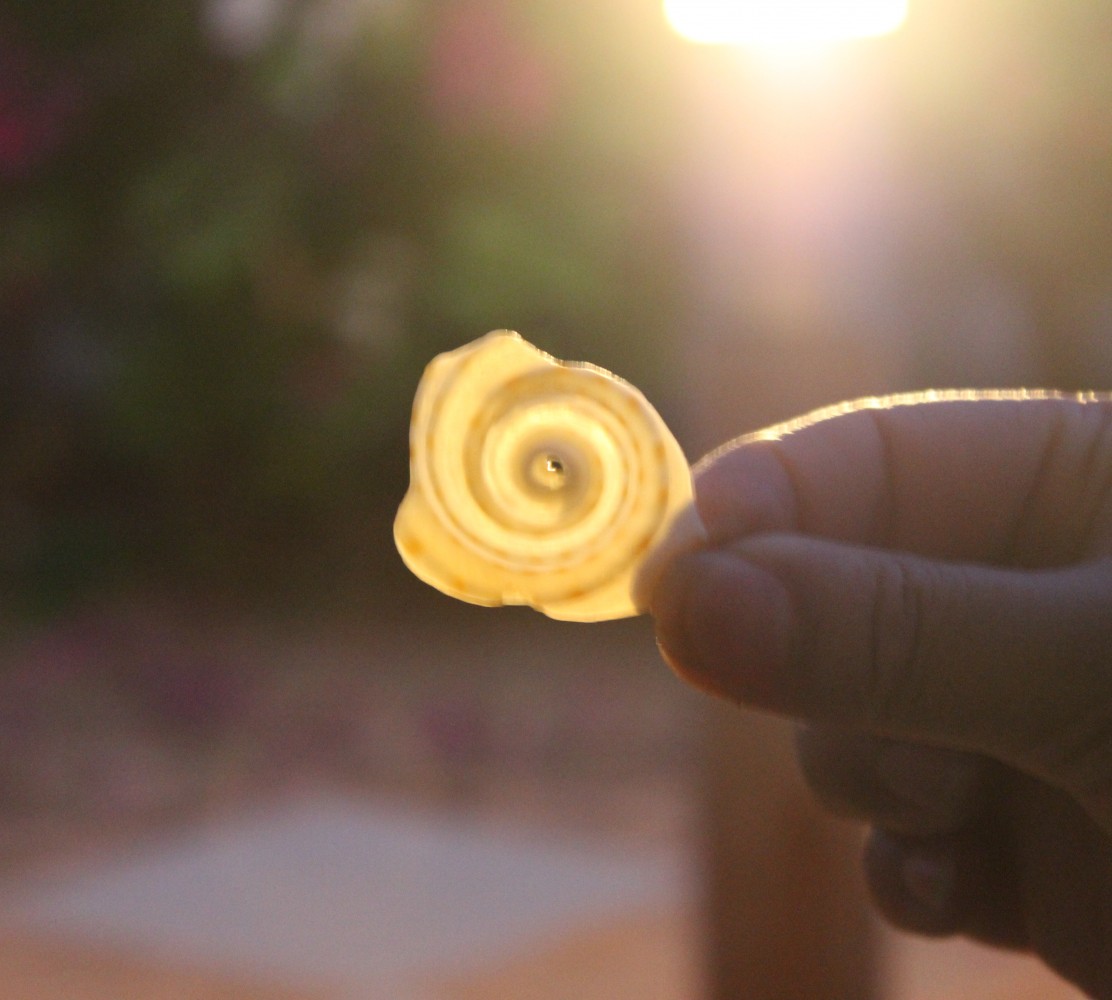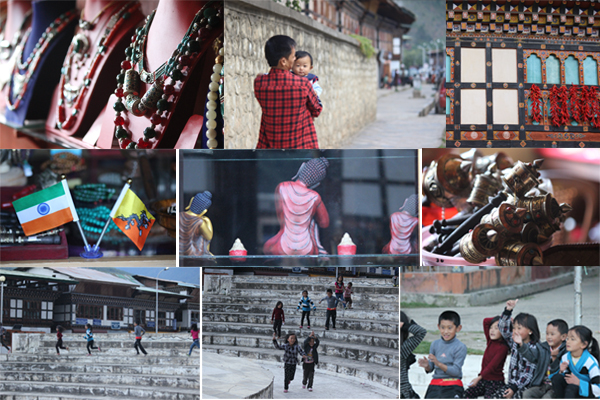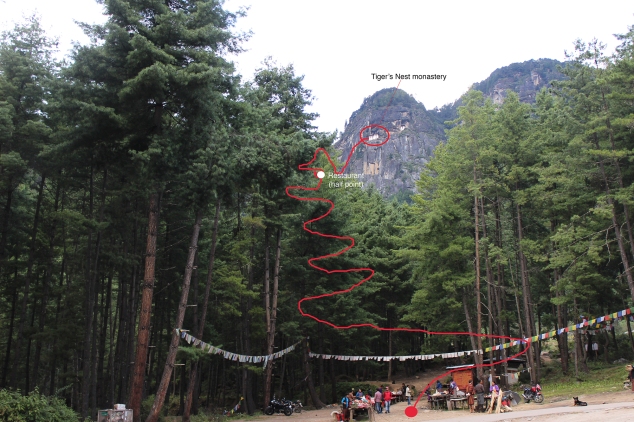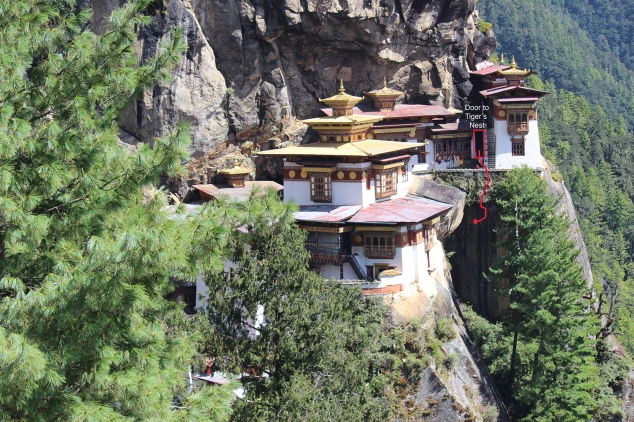Paro is huge, but it retains the charm of a town, infact it comprises of a group of towns, unlike Thimpu which did look like a city. We reached here by noon from Thimpu on the 30th. Paro is home to most of the world famous spots like the Thaksang Tiger’s Nest Monastery and many Dzongs, big and small. Our stay at Paro was pre-booked by us at Hotel Jigmeling, which is centrally located near by Paro Market lanes. We were to stay here for 3 nights, given the number of things to do here it seemed like a good idea to stay that long.
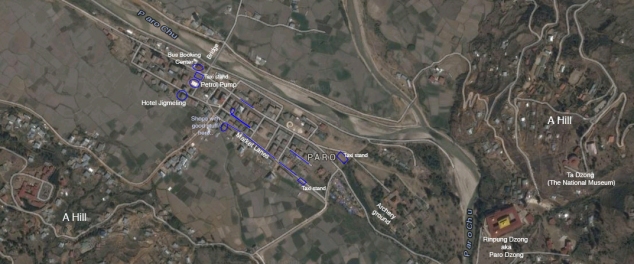 We paid a sum of Rs./Nu. 2100/- per night for a room for 3 people at Jigmeling. They are a very helpful and friendly bunch, Chimi the Manager is chirpy and jovial, always accompanied us during our meals with his quirky one liners. They were always keen on serving us food with lots of care and love. However, you always need to order your meals in advance, as they do not run a full-fledged kitchen, they require preparation time. Most eateries in the town close early in the evening, except some bars and pubs in the vicinity. Mornings are often early when you are in Bhutan, your day tends to start by 6 – 7 a.m.. Our room had a beautiful view of the fields in the backyard.
We paid a sum of Rs./Nu. 2100/- per night for a room for 3 people at Jigmeling. They are a very helpful and friendly bunch, Chimi the Manager is chirpy and jovial, always accompanied us during our meals with his quirky one liners. They were always keen on serving us food with lots of care and love. However, you always need to order your meals in advance, as they do not run a full-fledged kitchen, they require preparation time. Most eateries in the town close early in the evening, except some bars and pubs in the vicinity. Mornings are often early when you are in Bhutan, your day tends to start by 6 – 7 a.m.. Our room had a beautiful view of the fields in the backyard.
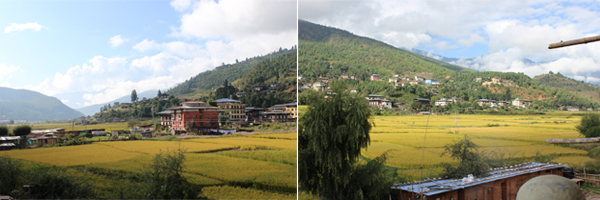 The first evening in Paro, we just spent strolling in the market, observing the laid back life. It was a festival day and hence most of the town appeared closed and sleepy. With the quiet river stream Paro flowing around, we only walked around the lanes of the town. Locals are fond of playing carrom board on the sidewalks, may be outside any shop you will find the community bonding over carrom and some tea. We planned to do the Thaksang Monastery Trek the next day, so we needed to get good sleep and rise early for the hectic day. We headed back to Jigmeling, had some dinner and dozed off dreaming about the beautiful Tiger’s Nest monastery.
The first evening in Paro, we just spent strolling in the market, observing the laid back life. It was a festival day and hence most of the town appeared closed and sleepy. With the quiet river stream Paro flowing around, we only walked around the lanes of the town. Locals are fond of playing carrom board on the sidewalks, may be outside any shop you will find the community bonding over carrom and some tea. We planned to do the Thaksang Monastery Trek the next day, so we needed to get good sleep and rise early for the hectic day. We headed back to Jigmeling, had some dinner and dozed off dreaming about the beautiful Tiger’s Nest monastery.
Next morning we realised we had not ordered for our breakfast. We could not get anything as breakfast at hotel closes by 9 a.m. We had got ready only by that time. So we had to rush out, as we were already late for the trek. Ideally locals will advise you to begin your trek at 7 a.m. in the morning, so that you descend in time before it begins to pour (it often does rain there). We couldn’t pursue the trek without food, so we decided to hunt for a place that was open at 9 a.m. You’d only get hard luck in that case, its too early for anyone to open their kitchen in Paro. But we did find a place called ‘Europeans Cafe’. Unfortunately it only serves italian items, but it was the only place that had its kitchen ready to serve. We ordered some pizza and Coffee to go with. A good cup of coffee was served. One of us headed into the local market to get some fruits for the day, and she also found a taxi to take us to Tiger’s Nest. We agreed for a Nu.250/- for one way, on the way back he duped us to pay Nu.500/- as he will be bringing the taxi empty to pick us up later in the day. Later we found from one of our local friend, that it only costs about a total of Nu./Rs. 400/- to hire a taxi to go and come from Thaksang Tiger’s Nest.
At Thaksang, you get dropped at the foot of the mountain. You will need to buy sticks to carry on the trek, it is a helpful prop to keep you going. The open shops at the foot offer such sticks for Nu.50/-, expensive, and they don’t return you the money if you return it. You can simply take it with you, lend it someone may be at the hotel. We began our ascend at about 10:10 a.m. As per the standards, we were horribly late to start with. We looked at the monastery that was visible at the top – looked like a long way to go for us non-trekkers, we gulped and moved.
Tiger’s Nest is approx. at the height of 10,240 ft above sea level. From bottom of Paro valley you need to climb a distance of above 2,300 ft. to reach the monastery. The whole ascend took us about 3 hours of walking, although we took like few breaks to catch our breath. The restaurant is supposed to mark half point to the monastery(it really is, the picture above does not do justice to the effort you need to put in)
 Above images were taken after we had completed almost 1/4th of the ascend, that’s right – only 1/4th. You will be glad you have a stick to support you. The path has ups and downs, so the monastery might look near and far intermittently, that means you can’t just assume the distance from how it looks.
Above images were taken after we had completed almost 1/4th of the ascend, that’s right – only 1/4th. You will be glad you have a stick to support you. The path has ups and downs, so the monastery might look near and far intermittently, that means you can’t just assume the distance from how it looks.
We did halt at the restaurant, but didn’t eat, as we had a heavy late breakfast of pizza, we weren’t going to feel hungry till 3 p.m.! So our late start did have some perks, we saved on lunch 😛 And also the restaurant lunch is too expensive, 40 ml juice bottles were about Nu.60/- thrice the original price. Well, given the distance they have to carry the stuff up, you can give it to them.
If you see these 2 spots around you, half your battles are over, you’re almost there – wait! Not really, another taxing one hour to go with an additional feature of 2000 steps to climb 🙂 Honest advise – drink up from the little streams and water taps you find on your way up, very refreshing and energising.
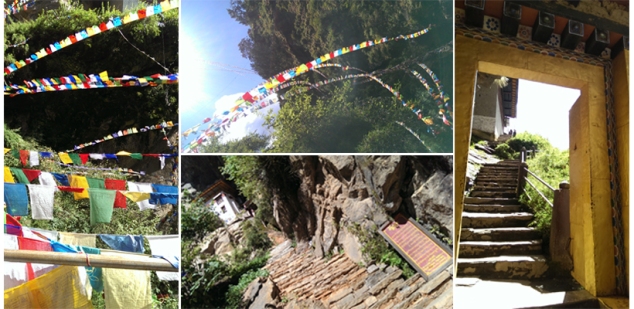 But if you see this, it means you have reached the monastery. Just a few more steps to climb and 4 more floors to check out at the monastery, only by now you must stop complaining about the pain in your legs – there won’t be mercy. The cameras or even bags won’t be allowed into the monastery. It is a beautiful place, where you must make it a point to sit down and take a while to soak in the beautiful paintings on the walls and the magnificent statues of Buddha, Guru Rimpoche and many other gods being worshipped here. There are approximately 7-8 different temples within the monastery. While you walk each floor and get into different rooms, you are bound to miss the Tiger’s Nest cave itself. We saw many tourists pass it through without even noticing the cave. It is a deep cave, that moves down the spine of the gorge the monastery is placed at, about 15 steps down. It is called the Tiger’s Nest in some relation to a story – This Buddhist enclave was consecrated as the site where Guru Rimpoche, riding a flying tiger, faced, battled, and defeated the demon that lived on the mountain. This pious deed was remembered in the construction of the monastery. It reminded me of the cave that used to be at Vaishno Devi in Jammu, India, till the late 90s, which the disciples would have to cross to get a glimpse of Mata, until someday a bomb was planted in it causing it to be closed down forever. Also called the Sherawali Mata (Goddess riding a Tiger)
But if you see this, it means you have reached the monastery. Just a few more steps to climb and 4 more floors to check out at the monastery, only by now you must stop complaining about the pain in your legs – there won’t be mercy. The cameras or even bags won’t be allowed into the monastery. It is a beautiful place, where you must make it a point to sit down and take a while to soak in the beautiful paintings on the walls and the magnificent statues of Buddha, Guru Rimpoche and many other gods being worshipped here. There are approximately 7-8 different temples within the monastery. While you walk each floor and get into different rooms, you are bound to miss the Tiger’s Nest cave itself. We saw many tourists pass it through without even noticing the cave. It is a deep cave, that moves down the spine of the gorge the monastery is placed at, about 15 steps down. It is called the Tiger’s Nest in some relation to a story – This Buddhist enclave was consecrated as the site where Guru Rimpoche, riding a flying tiger, faced, battled, and defeated the demon that lived on the mountain. This pious deed was remembered in the construction of the monastery. It reminded me of the cave that used to be at Vaishno Devi in Jammu, India, till the late 90s, which the disciples would have to cross to get a glimpse of Mata, until someday a bomb was planted in it causing it to be closed down forever. Also called the Sherawali Mata (Goddess riding a Tiger)
Descend took us about another hour and half. But ofcourse it was less painful. On other note, while going up we noticed a lot of old tourists from across the world, who despite their age were walking away without complaining. Its weird how we being younger found it so damn taxing, we are such an unhealthy lot, aren’t we!
As we reached closer to the bottom at about 4 p.m., it began to drizzle. After reaching the foot we had to wait a few mins for the taxi to come pick us. But as soon as he did, we got in, and you wouldn’t believe the pouring that began. It was a heavy heavy rain. We were thanking our timing.
We didn’t have much energy in the evening, and we were hungry as hell. We had an early dinner and dozed off watching TV.
Next morning we lazed around and left for the Paro Dzong more closer to lunch time. There were too less tourists everywhere as we guessed most would be now at Thimpu for the festival. We didn’t mind the quiet, laid back atmosphere. The Paro Dzong or the Rinpung Dzong is an amazing place. You can’t help but sit down and gaze at the breathtaking valley down the hill. I could’ve spent hours sitting there, only if I was carrying enough food 😛 You would be thankful if you are lucky to find the dzong almost empty with very few people around.

Please note, they do not allow women to enter the Dzong if they aren’t fully covered on their hands and legs. The Ta Dzong i.e. the National Museum was closed due to renovation so we couldn’t see it.
 One of us had not withdrawn enough cash at the border, and we all had just enough cash to support our own self through next days. She had to convince the Hotel owner to lend her cash in return for the money she had transferred online into his account from India. After a day’s struggle and many conversations later, they agreed to help us, and gave us cash. If you transfer online, the banks in Bhutan receive them after a delay of about a week only. Still they trusted and helped us, we provided with all proofs for them to keep. The last day on Friday we checked out of the hotel, said good bye to our lovely hosts and headed back to Phuentsholing in a taxi. You can read about all our commute expenses on this blog post.
One of us had not withdrawn enough cash at the border, and we all had just enough cash to support our own self through next days. She had to convince the Hotel owner to lend her cash in return for the money she had transferred online into his account from India. After a day’s struggle and many conversations later, they agreed to help us, and gave us cash. If you transfer online, the banks in Bhutan receive them after a delay of about a week only. Still they trusted and helped us, we provided with all proofs for them to keep. The last day on Friday we checked out of the hotel, said good bye to our lovely hosts and headed back to Phuentsholing in a taxi. You can read about all our commute expenses on this blog post.
Read about our food experience on this trip, and Thimpu.
